The Impact of Social Media Marketing On Branding and Brand Loyalty in the Fashion Industry
- 71 Pages
- Published On: 22-05-2024
Abstract
Social media has significantly influenced every individual along with companies throughout the world that no one can simply overlook. It has been a runaway achievement throughout the world in every industrial segment, comprising the fashion industry. Fashion brands consider it an important marketing medium. Customers’ purchasing decision regarding fashion products has evolved with the facilitation of social media marketing. Currently, almost every customer is actively involved in social media in order to seek information regarding any products and service and the marketing strategies of companies are also created on a social media platform. Sharing of information, knowledge, and experience by the customers in social media act as word of mouth strategy for fashion brands. With the influence of word of mouth and social media marketing, it has an impact on branding strategies of fashion companies and customer brand loyalty. Based on this aspect, the research intends to analyze the impact of social media marketing on branding and brand loyalty in fashion brands. The research is based on a quantitative approach where questionnaire survey has been used in order to collect information. About 100 respondents are surveyed in order to understand their opinions regarding social media marketing activities by fashion brands and their loyalty towards the brands. The correlation and regression analysis are conducted in order to analyze the relationships between the variables. The findings of the research indicate that social media marketing is effectively influencing the branding activities of fashion companies. Nowadays, fashion brands are shifting towards using this new channel for marketing and promoting their products and for interacting with customers than traditional market channels. Social media marketing activities are also influencing the brand loyalty of customers. Fashion brands which are actively involved in social media marketing, such as developing trendy contents for marketing, updating information regularly and creating interesting advertisements can result in purchasing and repurchasing intentions. Therefore, on the basis of these results, it can be recommended that marketers in present days require focusing on creating a positive image in social media, developing a good impression and actively involving with customers in order to create strong brand loyalty.
Chapter 1: Introduction
1.1 Research Background
With the introduction of the World Wide Web, the improvement of the information age has transformed the way people used to communicate in the past. The Internet has created a sole social and cultural background for every individual, and additionally changed on the way information is shared, the way people conduct business activities and the way people interact. The improvement of social media on the internet has transformed the manner people cooperate with each other and share knowledge and experience. Social media is acknowledged and is quite popular among millennial units (Nanji, 2017). This new generation people are quite strong and sophisticated, who are hard to motivate, persuade and retain. They are profoundly active in social media and always seek information. Due to this social media, and attitudes of modern generation people, the whole marketing background is changing. Organizations are presently much active in social media in comparison with traditional times. Many companies have more than one presence in social media websites in order to communicate with the people (Devi & Menezes, 2016). Social media presence is not only important for creating brand awareness but without it is likely that companies will lag behind from the rivals who are actively involved with the fans and followers.

Social media marketing provides organizations with an interactive platform to communicate with people in creating the brands and loyalty that surpasses the ability of traditional ways of marketing in the past. Customers are utilizing the social media as a source to seek product information, for example, the brand, background of the producer and retailers while making a purchasing decision. The choice of brand is highly inspired by word of mouth in social media channels. The persuading influence of social media is observed as a prospect for companies to motivate customers by utilizing diverse methods (Ler, 2014). Customers are looking more than pricing for the purchase when they are researching for it on the internet. It is also the experience that customers want to know from other users, which can be obtained through social media.
Among other business, fashion companies are using social media channel in order to develop relationships with the customers. The emergence of social media has boosted interest in viral marketing among the fashion brands. Fashion has become a trend and is existed everywhere owing to social media. Social media provides customers with unlimited space for self-expression. Unlike fashion-oriented magazines and television programs, there are many fashion social media websites, which are updated regularly with new fashion trends (Kim & Ko, 2010). The social media’s effectiveness for fashion brands is due to its robust individual, personal and elitist perspective. Its involving experience provides customers the prospect to voice opinions regarding any brands. Fashion brands view social media as key influencer. While depending on the styles of their individual design, aesthetic value and innovation, fashion brands have traditionally neglected aspects like customer management and customer relationships (Mohr, 2013). However, currently due to social media, this industry has heated up with new customer trends and behaviors.
Continue your exploration of Interactive Marketing in the Digital Era with our related content.
1.2 Research Problem
In recent times, with the emergence of numerous fashion brands and resulting high competition have led to new challenges for fashion companies. Fashion industry is one of the lucrative and lively industries in the globe. It represents about $3 trillion and signifies 2% of world’s GDP (Fashion United Group, 2017). As a way to provide value to the customers, fashion brands have presently turned into social media. Use of social media websites has already extended to almost every fashion brand and has been assessed as business take off instruments. Social media has started to benefit the fashion industry while brands and customers are creating and strengthening relationships through this medium. Especially, brands are capable of familiarizing themselves and give information while involving in casual communication with the customers. Customers are gradually shifting away from traditional media towards digital media such as social media for obtaining information (Kim & Ko, 2010). Customers are actively involving in the social media platform in order to contribute and seek information regarding a brand before choosing to purchase or not.
In the light of social media, it is likely that brand loyalty would be facing notable change as marketers are no longer in the position of the hierarchical authority in pushing brand awareness, which occurred in traditional marketing medium. Nowadays, companies and customers are co creating brand loyalty by several involvement functions in social media platforms. It is vital for marketers and companies to comprehend the marketing efforts in social media and creating brand loyalty as customers can consider liking a brand in social media is regarded loyal. In short, brand loyalty from the viewpoint of millennial can be different in comparison with the old generation people (Jayasuriya & Azam, 2017). Traditionally word of mouth involved people comprising family members, friends and peers among others. Nevertheless, in present days, social media platform has become unusual word of mouth where people trust the words from different unknown users, which may not be friends or family members. Presently, customers are actively sharing their experiences regarding a brand they used towards the mass audience in social media platform. This sharing is equivalent to word of mouth and it is not commercially determined. In social media, the trusted source of information has changed from known individual to unknown people in the online society, and companies as well can inspire the word of mouth in social media (Zhung, 2017). Thus, the change of marketing seeks lots of understanding for marketers and companies in creating positive brand experience towards the customers.
1.3 Research Objectives
Continue your journey with our comprehensive guide to User-Controlled Social Media.
With the increased utilization of social media as a way of marketing communication for fashion brands, it has become essential to empirically evaluate the effect of social media marketing on branding and brand loyalty. Based on this aspect, the key objectives of the research are:
- To evaluate the use of social media marketing for branding purpose and brand loyalty in the fashion industry
- To critically examine the impact of social media marketing on branding and brand loyalty in the fashion industry
- To suggest ways and methods that the companies in the fashion industry can apply for more effective use of social media marketing for branding and brand loyalty
1.4 Research Questions
For the specific research objectives, the key questions that have been answered through the research are:
RQ 1: How social media marketing can be used for branding purpose?
RQ 2: How does the use of social media marketing influence the branding and brand loyalty in the fashion industry?
1.5 Research Significance
The research plays pivotal role to give an understanding of existing fashion segment and social media context. The critical components examined in the research have considerable influence on customers’ decision to purchase a fashion brand. Due to emergence of digital and social market channels, the trivial for retaining the loyal customers have become tougher. Customers are currently exposed to various fashion brands regularly in social media platform and there is notable change in branding and brand loyalty among companies and customers. The evolving requirements of the new generation people in today’s digital and electronic age and the loyalty pledge to brands are no longer satisfactory as customers are extensively exposed to newer fashion brands in social media, which are thriving to establish relationship with customers (Kodippili & et. al., 2014). Hence, the research can provide knowledge for marketers of fashion brands to effectively involve with the customers and create brand likings.
1.6 Research Structure
The following figure demonstrates the whole structure of the research.
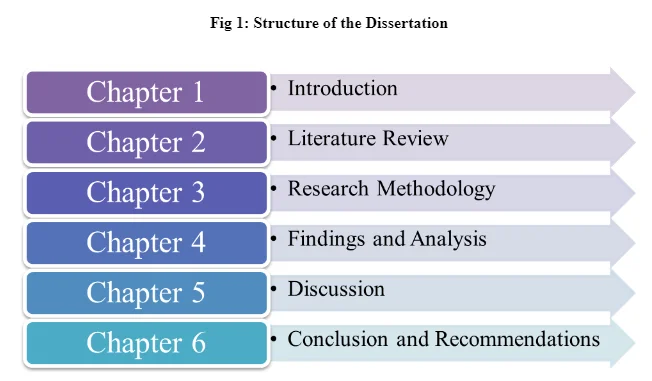
Chapter 2: Literature Review
2.1. Social Media Concepts
As per the views of Safko & Brake (2009) demonstrate the fact that social media is considered to be activities, behaviors and practices prevailing among the people of the society gathering resources online in order to share the information, opinions and knowledge through the utilization of the conversational media. social media is the tool that is utilized for communication possessing Web 2.0 features which implies the fact that they are participatory, collaborative possess knowledge sharing tools that is present over the web.
Shau, Muniz & Arnould (2009) reveal the fact that social media is considered to be an efficient utilization of the time and resources and tends to offer the companies with proper communication tools with consumers so that they can develop brand loyalty. As per the study that has been done by info-graphics it is noted that most of the Twitter and Facebook user tends to reveal the fact that they have started to talk about, suggest and buy the product of the company soon after they started to involve themselves with the company over social media. As per the views of Thackeray. & et. al. (2008) businesses are capable of stimulating the goods and services, offer proper support and thus develop an online community related to brand enthusiast by means of all types of social media such as social networking sites, virtual world, online gaming sites, new sites, forums, blogs and so on. Trusov, Bucklin & Pauwels (2009) reveals the fact that social media helps the consumers to share information with friends regarding the products and services brands. The conversation that takes place among the peers helps the companies with cost effective ways to enhance the brand awareness, improve the brand recognition and also raise the level of brand loyalty. Hence, it can be stated that social media assist the firms in order to create brand loyalty by means of networking, conversation along with community development.
2.2. About Social Media Marketing
As per Vollmer & Precourt (2008) social media marketing proves to be different in comparison to that of the conventional methods of marketing. Hence, there is need of major attention and strategy development in order to attain brand image as well as loyalty. In order to remain competitive in the present times, there is need of solid social media strategy. The companies keep social media experts along with consultants so that they can decide regarding toe contents along with features of their offer and different activities in social media context so that it is capable of winning the heart and minds of the consumers and thus brand loyalty can be attained.
As mentioned by Wolcott (1994) consumers are likely to visit the social media sites so that they can have proper idea regarding the products and services of the company along with the promotional campaigns. As viewed by Yen & Gwinner (2003) customers perceive social media site to be a service channel where they would be able to involve themselves with real time bases with the business houses. Yet, there is need of updated contents over social media sites according to the customers. Hence, it is because of this reason Google has altered the entire algorithm of search system so that the customers would be capable of viewing updated contents over social media sites. As per Muniz & O’Guinn (2001) customer being exposed to several brand messages over social media platform scan the content that doesn’t proves to be significant to them. Hence, it becomes quite significant to offer relevant contents in order to manage the brand over social media in a successful manner. The main reason behind engagement with different brands over social media sites has been the popularity of social media platform along with content among friends. Owing to the fact that there are different social media platforms, it becomes quite impossible to involve in all of them, marketers are supposed to assess their target audience and understand to participate in the effective platform in order to communicate with them. Offering mobile application can assist the customers to get involve with the brand each day and thus develop brand loyalty.
2.3. Different Types of Loyalty Attained Through Satisfaction
2.3.1. Customer Loyalty
As per the views of Nambisan & Baron (2009) it has been identified that a loyal customer is considered to be the person who tends to make repeat purchases and promotes the brand to someone else. Consumer loyalty is considered to be the main goals of customer relationship management. Park & Cho (2012) states the fact that customer loyalty takes place because of the positive emotional feelings that takes place towards a particular brand in the minds of the customers. Loyalty actually is the result of the positive experiences and the satisfaction of the perceived value that takes place. Attraction of the new customer proves to be quite expensive in comparison to the retention of the prevailing customers. Maintaining of the known customer is considered to be the cost-effective method that shall assist in leading to the customer satisfaction and customer loyalty.
2.3.2. Behavioral Loyalty
Many marketers consider customer loyalty in repeat purchases that by solely depending over the repeat purchases would lead to profits, however, it is considered to be one type of customer loyalty and it is known as behavioral loyalty. In case it is a service providing organization, then under such cases this type of customer are viewed on a regular basis. As per Phelps & Et. Al., (2004) the one who are behavioral loyal can assist the company to generate huge revenues and are also important for the company. However, in case they are dissatisfied with the product or services they would definitely switch to some other competitors and they would spread negative word of mouth that would have an impact on the potential customers.
2.3.3. Attitudinal loyalty
As per Roehm & Tybout (2006) there are few loyal customers who help in the minimization of the cost linked with customer education and promotion and tend to share positive word of mouth when they become the promoter of the brand. This is identified as attitudinal loyalty. These types of loyal customers are found not to switch to the competitors owing to the supplier issues and even the offered products as well as services would not march with their needs and demands. Under such cases, they try to interact with the business and thus correct where the organization is wrong by investing their time without expecting for any types of return owing to the fact that the bond taking place between the attitudinal loyal customers along with the particular brand tends to be quite strong.
As per Chan & Ngai (2011) the marketers try to develop attitudinal as well as behavioral loyal customers instead of possessing any one particular type of customers. Marketers try to attain them by being ethical and democratic and by meeting the needs and demands of different customer segments and making use of distinct strategies.
2.4. Social Media Marketing and Its Impact on Fashion World
As revealed by Chu & Kim (2011) it is with the use of the social media that leads brand and customers closer than before. In the present times there have been changes in terms of association that brands have with that of the customers. In new hierarchy, the consumers are found to possess the capability in order to increase or negatively impact the business by sharing either positive or negative responses. This proves to be quite evident in terms of fashion world. Most of the fashion shows, exclusive events and other top names in fashion related news can be viewed live by numerous viewers at a time. In the olden times, designers as well as fashion lines were assessable only by means of magazines and press. In the present times, a person can keep up with latest fashion by monitoring the content that has been attached with the hangtag. In the previous times, the main platforms that people used were Facebook as well as Twitter. However, in the new era different players are on the scene. Churchill & Iacobucci (2005) states that Instagram has reached more than 800 million users and these users are found to possess highest level of involvement. It is Instagram that has minimized the gap taking place between fashion brands and buyers. They get connected to each other by means of shared interest instead of by means of catwalk show as well as print advertising campaign. Such thing tends to urge the brands to contemplate more regarding the real people and with numerous bodies, fashion preferences. There has been new addition to the Instagram shopping as well where the brands are capable of tagging products in their post that might lead users to point of sale.
Bilgin (2018) in his research tries to determine the impacts of social media marketing activities over brand awareness, brand loyalty and brand image. The author also tries to evaluate the effect of brand awareness as well as brand image over brand loyalty in this particular research. The chief population of the research has been the consumers who tend to make use of the five brands with maximum social score over social media communication channels such as Facebook, Twitter and Instagram. The researcher tries to make use of the quantitative method and data has been attained by means of online questionnaires that have been shared over the social media sites by implementation of the convenience sampling method. It can be noted that social media marketing activities has been noted as effective factors over brand image as well as brand loyalty. It has also been noted from the research that brand awareness as well as brand image possess a major impact over the brand loyalty. From the research, it has been evident that brand awareness possesses a limited impact over the brand image.
In the present times, it has been noted by Colgate, Buchanan-Oliver & Elmsly (2005) that the peer recommendation proves to be quite valuable and easily accessible in comparison to traditional times. Word-of-mouth has a major power, but with social media it possesses the capability in order to spread the news rapidly than ever before. Out of the Instagram total audience, near about 200 million users are following one particular fashion account, 45% of the users belonging to the Britain states the fact that they follow such fashion accounts in order to attain inspiration basically for looks that they can purchase and develop themselves. The main part of this process can be considered to be sharing of their own looks as well with #fashion that is stated bear about 13 million times in a month and OOTD (outfit of the day) that is featured in more than 140 million posts till the present times.
Comm (2009) reveals that there are several social media users who take into consideration peer validation when they tend to post any types of contents. From the survey, it has been found that most of the people tend to make online purchases in case the product and services has been suggested by others. Along with this, 84% of the Millennial tends to be impacted in order to make a purchase as per the user-generated content made by the strangers who has used the products and services quite a couple number of times or at least once. Taking into consideration such concepts, it has been identified that fashion brands pay huge attention towards the Instagram in order to reach the target market. The utilization of the social media leads to proximity amongst the brand as well as the customers. As per Constantinides & Fountain (2008) it is quite significant to develop a proper conversation around the brand and the product. It is considered to be one of the main reasons behind the fashion brand to make use of influencer marketing into digital strategies. The main strategy behind the influencer marketing comprises of working with influential personas. For instance, a blogger or user possesses a high social following with the objective to escalate the awareness of the brand or impact the buying pattern of target audience. In the present times, it has been identified that the social media as well as influencer marketing has altered the fashion world. The consumers are found to be quite connected with the brand that before and feel good to post regarding the names that they love. By implementation of the Instagram, shopping has altered the method of fashion retailing.
In UK, there are three main brands such as haute look, Lacoste and banana republic who are considered to be the main players practicing social media in an effective manner. Facebook generally has fan base which is higher than other social media platforms, the fashion retailers attain huge coverage over such platforms. Under such cases, it tends to replace the conventional communication and it tends to have an impact over the consumer buying behavior. There are huge evidences of the studies that study the impact of social media marketing over value creation such as sales, brand awareness, customer involvement and so on.
2.5. Customer Satisfaction through Social Media
Fischer & Reuber (2011) satisfied customers help the companies with rise in the level of revenues and decreasing operating costs. Hence, the companies make all the efforts in order to keep the customers happy. With the growth in the level of competition, stagnation in the year 1990s, it was important for the business houses to be concerned regarding the customer satisfaction surveys. These surveys became quite difficult. When focus upon the customer satisfaction program became quite tough, creation of the programs in order to comprehend the customers in a proper manner became the main objective for most of the companies.
Constantinides & Fountain (2008) states that company knowledge can be considered to be the main source of information regarding critical performance components. Nonetheless, it is well known fact that customer satisfaction needs to be extended beyond the company and solely to the customers. It becomes significant to place emphasis upon the network performance improvements in order to drive customer satisfaction. It becomes significant for the company to ascertain performance drivers related to satisfaction and thus prioritize them.
It has been noted by Roehm & Tybout (2006) that the core of customer satisfaction is difficult to reject and the delighted customers would offer free advertisement for the organization. The companies are supposed to pay attention towards the consumers so that it can attain its strategies and methods. It becomes profitable for the companies to sell the goods to the existing customers rather than locating new ones. Hence, most of the companies are found to set their strategies in a manner that would lead to customer retention and tries to be customer centric as well as service oriented.
2.6. Impact of Social Media on Marketing
As per Constantinides & Fountain (2008) it is noted that marketers place greater emphasis in order to grab the attention of the consumers. Owing to the fact that people make use of new media and technologies such as smart phones, it has offered the marketers with the scope to reach the consumers all through the day through different means. In improves the scope of messages being viewed. Hence, the marketers need to be allured towards the social media sites. The campaigning methods that were used in the previous times are overshadowed because of the interest of the marketers in the social media sites which are easy to utilize. The main issue lies with the alteration in the mindset of the people. It is the social media that has led to active involvement, quick access to anything and constant communication. Roehm & Tybout (2006) states that social media has been capable of attaining something which traditional advertisement would not have been able to attain. It is Facebook, Instagram, and LinkedIn that is capable of directly capable of meeting the increasing demand of the consumers. Along with its initial involvement, the social media activity might sustain for a longer period of time. The impact of social media might be found over television advertisements which shall sign off with request to the consumers in order to visit the websites such as Facebook or Twitter page that offers the promise of exciting online experience along with sense of community. As per Fanion (2011) the consumers are found to make use of the social media basically for fun and it doesn’t make any difference for them if they join a branded or unbranded game. Nonetheless, it is well known fact that if the brand is quite successful and creative, then consumers would definitely create a sense of loyalty towards the hosting brand. It is to be noted that different campaigns have taken huge advantage of technological tools. With such tools advertisers are capable of understanding where there message is leading towards.
According to Corstjens & Umblijs (2012) fashion wear industry is considered to be one of the most attractive and lively industry. This industry tends to prove to be perfect for the social media marketing because of the fact that it is dull of glamour that would fantasize the person. Fashion industry tends to be highly esteemed and is based upon high brand resources. Hence, with the objective of creating a brand value, fashion brands have turned their eyes towards social media marketing. In the present times, social media has become too advanced and solid medium for connecting and remaining informed regarding any type of product and services. The impact that social media marketing has over brand equity has been assessed by different studies. The findings revealed the fact that social media has been determined as an influence over brand image instead of conventional media that pays attention towards the brand awareness. They further revealed the fact that being an element in the communication mix; social media possess major impact over the brand equity (Roehm & Tybout, 2006). In this particular study, brand equity has been assessed according to Keller’s brand equity components.
Chapter 3: Research Methodology
3.1 Chapter Introduction
The main purpose of the methodology chapter is to critically analyze the methods or approaches and different tools and techniques that have been implemented throughout the overall research work. Additionally, the discussion made in this chapter also provides clear justification as well as rationale of each approach or method and tools that have been applied to conduct the research study. The methodological chapter of the study has been constructed with few major sections including research philosophy, research approach, data collection and data analysis, sampling process and ethical considerations. These sub-sections are considered based on the standardized of an academic research work and it has been found to be phenomenal role to draw credible conclusion in relation to the primary aim and objectives of the current research.
3.2 Research Philosophy
Research philosophy refers to a set of beliefs regarding the process through which the data and crucial resources linked with the associated with research phenomenon will be gathered and evaluated. Moreover, research philosophy is also argued to deliver adequate support in in terms of presenting philosophical assumptions and views regarding the chosen subject area as well as the aim and objectives of the research. Research philosophy can be categorized into four broad categories such as positivism, pragmatism, interpretivism and realism (Bryman, 2007). While talking about the current research work, the overall research has been conducted in a positivism philosophical approach. The main intention of selecting positivism approach in this research is that the philosophical approach can help the research to gather large volume of data with applying scientific enquiry. Moreover, the positivism philosophy is an independent principle which implies that the views as well as assumptions undertaken in the whole research work do not have any influence the existing research inference.
3.3 Research Method
Selecting an appropriate research approach is one of the most crucial steps as it determines the success and failure of any project. In order to select the most appropriate method for the research, it is highly essential for researchers to consider few major factors such as research goals, statistical significance, quantitative and qualitative data resources as well as the sample size of the project (Creswell, 2011). In general, there are basically two forms of research methods namely, qualitative and quantitative research method. Qualitative method in research refers to a scientific approach of observation in order to gather non-numerical data relating to the primary research aim and objectives. This type of research method seeks to evaluate gathered data using relevant theoretical frameworks that are clinically appropriate to draw credible findings. The practices applied in qualitative research may include one-to-one interview, focus groups, ethnographic research, case-study research, record keeping and observation process.
On the other hand, the quantitative research method refers to an approach which helps to increase understanding behavior through using relevant statistical and mathematical instruments. The quantitative analysis in research often involves representing reality on the basis of findings gathered from numerical values. From a general point of view, there are four types of quantitative methods than can be applied when conducting any research. They include descriptive, correlational, quasi-experimental and experimental method (Kothari, 2004). When talking about data collection techniques, quantitative research seeks to evaluate numerical data that are usually gathered from primary sources such as survey and questionnaire analysis among others. In this current research, the overall study has been conducted using a quantitative method as the method is relevant in terms of drawing credible findings of determining and justifying the impact of social media marketing on branding and brand loyalty in the fashion industry. The method has provided a valuable insight in order to gather large volume of primary data. In data collection process was conducted using relevant tool such as questionnaire survey which has enabled the current research to collect and appropriately analyses data to draw the most suitable conclusion.
3.4 Sampling Technique
In research, sampling refers to a process of selecting any specific group of individuals or objects taken from a significantly large group of population for measurement. In quantitative research, sample size is considered as the representative of the selected population in order to ensure that the key findings gathered from the research sample are generalized and they are credible to meet the desired outcomes of the research (Gay & Diehl, 1992). In this research, a random sampling technique has been applied as it is easy to conduct and has high probability of achieving representative for gathering data and information for the research. Moreover, random sampling is also considered to be effective technique to meet large number of relevant statistical procedures for the research. Hence, the selection of random sampling technique has provided major insight in this research to draw credible findings. In this context, a total of 100 respondents have been selected from different demographic backgrounds such as their age, gender, income level as well as their attitude and behavior regarding different fashion brands. Moreover, the respondents have been selected randomly irrespective their frequency of following different fashion brands on current social media sites.
3.5 Data Collection Process
Data collection is notably considered as one of the most crucial parts when conducting any research project. It primary involves a process of accumulating data and/or information that are credible in terms of contributing to the research and determining the desired outcomes. In general, data can be gathered from two sources including primary data collection sources and secondary data collection sources (Greasley, 2009). The primary sources that widely used in research projects include survey questionnaire, interviews and observation among others. In this process, the primary data are gathered directly from the relevant sample groups who are involved with the issue or any phenomenon. Hence, it is also known as first-hand source and is more effectual in terms of gathering crucial data and information relating to the chosen research question and objectives (Myers, 2008). On the other hand, the secondary data collection sources may include relevant theoretical concepts and frameworks that can be used to increase viability and effectiveness of the research. In descriptive research, secondary sources play a crucial role in terms of applying providing evidence-based description about the findings. The secondary data collection sources are also effective in terms of gathering relevant facts about any specific phenomenon along with their relevance to the current research findings (Kothari, 2004).
In relation to the current research study, the data collection process includes both primary and secondary data sources. The primary data for the research has been gathered from survey questionnaire from the selected sample size. The survey data has enabled the research to gather numerical facts relating to the perception and view about the involvement of customers with the fashion brands through social media sites. Similarly, the research also includes secondary data sources in order to ensure that the facts and findings gathered from the primary data evaluation are theoretically approved. In this regard, the data collection process includes secondary sources such as academic books and journals, peer-reviewed journal articles along with different organizational publications from different online sources.
3.6 Data Analysis Process
In quantitative research approach, data analysis process can be a critical step as it seeks to apply mathematical and/or statistical formulas when evaluating data gathered from primary source(s). It is one of the most crucial steps in research as data evaluation techniques and procedures determine the overall validity and reliability of the research (Creswell, 2007). In the current research study, the data gathered from survey questionnaire has been labeled and analyzed using SPSS computing software. The use of SPSS software package has enabled the research to find appropriate numerical figure as well as graphical illustrations relating to the facts associated with the impact of social media sites in branding strategies of the fashion industry. Moreover, the charts, tables and graphs illustrated using SPSS software has also enabled the research to maintain credibility as well as clarity in terms of describing the key findings of the research. Moreover, the analysis tool has also been found to play a crucial role in terms of determining the influence of social media marketing on branding and brand loyalty practices in the modern fashion business industry.
3.7 Ethical Considerations
The notion of ethics has gained a major attention in the field of research globally. Research ethics is also considered as one of the most crucial factors for the researchers when conducting research over any specific issue or phenomenon (Saunders et al., 2009). From a theoretical perspective, research ethics is defined as a collective set of standards and guiding principles that are required to address or comply at each step of the research, especially in data collection and data evaluation functions (Oliver, 2010; Smith, 2006). In this research study, the code of ethics has been considered in order to ensure that the activities are conducted on the basic of fundamental research credibility and uniformity. The main factors relating to the research ethics that have been considered in this research are informed consent, data privacy and data security. In data collection process, all respondents included in the survey questionnaire have been gone through a standard informed consent form before their participation in the survey. Moreover, it was also ensured that the individuals are participated voluntarily. Moreover, the ethical concern relating to this research also includes significant attention when constructing questions for the survey. During the questionnaire construction process, it has been ensured that the survey does not include any question that can harm ideological beliefs, personal backgrounds as well as emotions of the participants.
Chapter 4: Findings and Analysis
4.1 Findings from Questionnaire
In order to understand how social media marketing can be utilized by fashion brands and how the marketing activities made by the brands impact on branding and brand loyalty of the customers, about 100 respondents has been surveyed. Their responses have provided significant understanding about social media marketing activities conducted by the fashion brand and their opinions on them.
4.1.1 Demographic Information
In the survey, most of the respondents were female and the age group of majority of the respondents (46 out of 100) has age group of 20 to 29 years. Furthermore, 34 respondents belong to age group of 30 to 39 years. This indicates that the opinions of the respondents are mostly millennial and represent present young generation of people. With respect to occupation, most of the respondents (33 out of 100) are students. 20 respondents are found to be private segment employee and 14 are self-employed. The following tables demonstrate the descriptive statistics of the demographic information of the respondents.
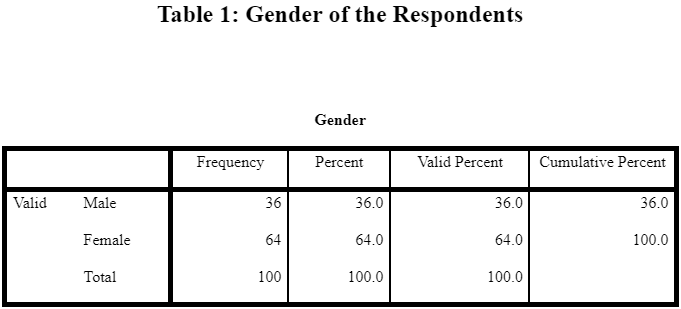
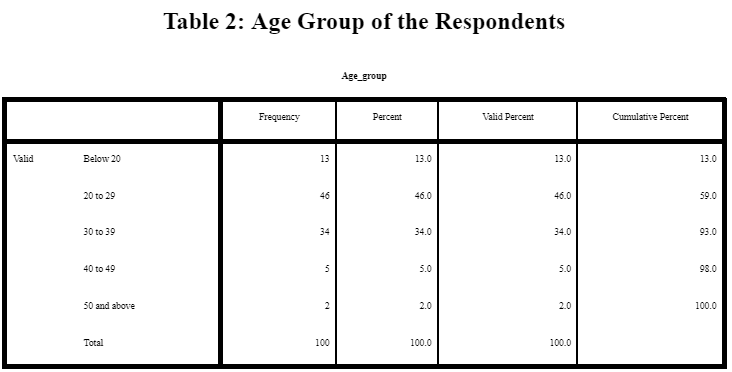
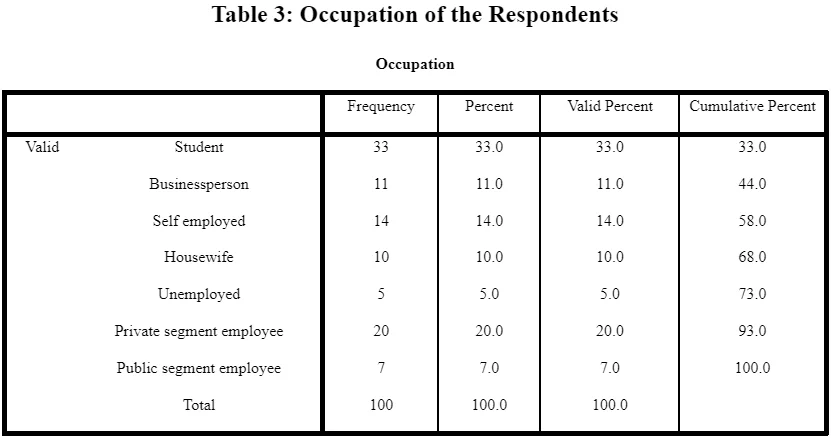
4.1.2 Social Media Usage
In order to understand about the usage of using social media, they are asked the most frequent social media network they use. In this context, majority of the respondents (41 out of 100) have mentioned that they use Facebook most. 30 respondents have also stated to use Instagram most. YouTube is the third most used social media platform used by the respondents. Apart from that respondents have also mentioned to use other social media applications like WhatsApp messenger most of the time (see following figure). This signifies that among other social media websites, Facebook is highly popular among the respondents and have significant influence on their purchasing style.
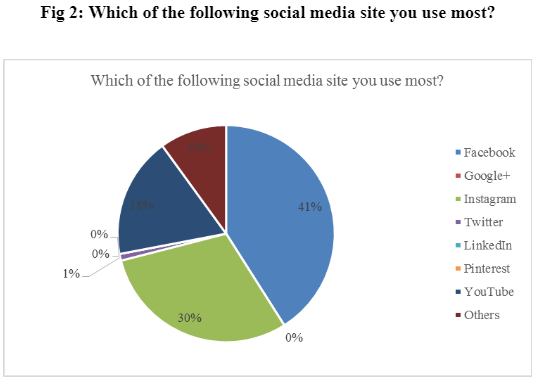
In order to understand the frequency of using social media, the respondents are asked about the amount of times they use social media. In this context, most of the respondents (about 51 out of 100) have stated that they use social media one to three hours in a day. 32 respondents also mentioned to use social media for about four to six hours in a day. The number of respondents who stated to use social media for less than 1 hour a day is 14 (see following figure). This specifies that social media consumes considerable amount of time for the respondents and therefore can have significant influence on their behaviors.
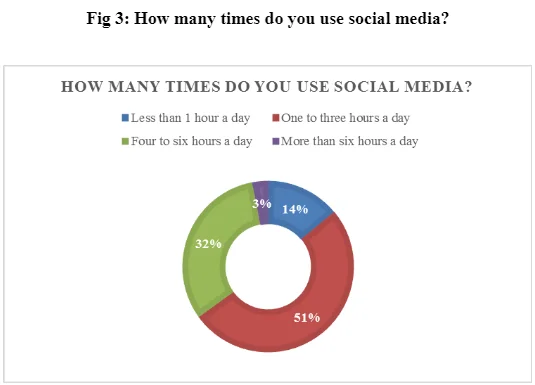
4.1.3 Social Media Marketing
To understand about social media marketing activities of the fashion brand, the respondents are first asked if they are conscious regarding popular fashion brands such as Prada, Nike, Gucci, Calvin Klein and Fendi among others. On this question, majority of the respondents (89 out of 100) have stated that there are few fashion brands they love. On the other hand, 11 respondents stated that there are no specific fashion brands they love; they just purchase what they like (see following figure).
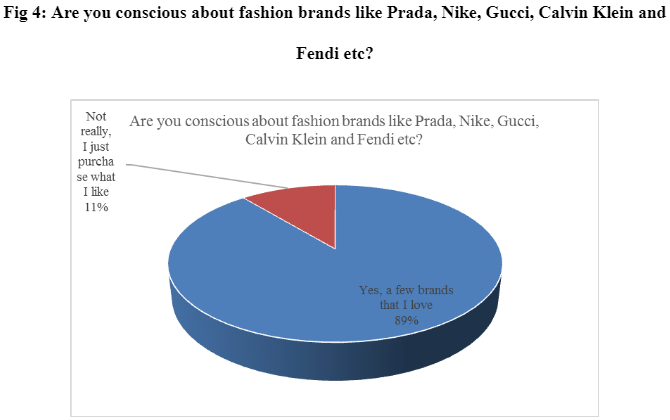
In the next question, the respondents are asked to consider any fashion brand they use or like and give their opinion on the social media marketing activities of the fashion brand on the basis of some statements. On this aspect, majority of the respondents (57 out of 100) have agreed with the fact that there are many marketing campaigns by the fashion brand in social media site. 24 respondents were neutral on this fact and only 6 and 3 respondents are disagreed and strongly disagreed with the fact (see following figure). This indicates that fashion brands are actively using the social media in order to market their products. Social media is important channel for their marketing campaign activities to be performed.
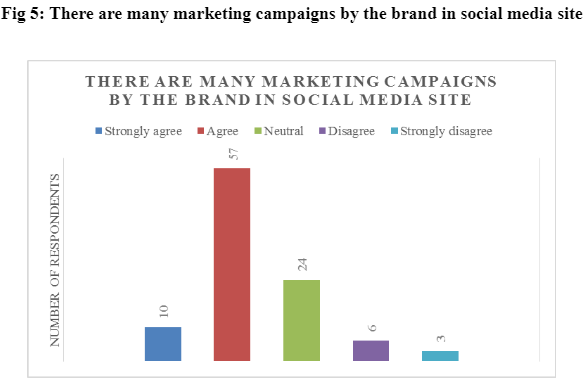
Most of the respondents (52 out of 100) also strongly agreed with the fact that the fashion brands regularly update the contents in social media (see following figure). Therefore, it can be stated that through social media channel, the fashion brands intend to provide up to date and current information regarding any offerings to the people. 21 respondents neutral on this aspect.
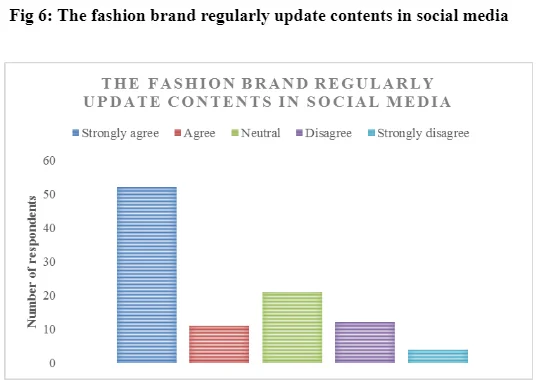
With respect to the relevance of the social media contents delivered by the fashion brands, majority of the respondents (54 out of 100) were neutral on the fact that social media contents are relevant for them. However, 17 and 9 respondents are agreed and strongly agreed with this fact (see following figure). This result specifies that there is some relevant information which can be known by the people regarding the fashion brand through social media. Hence, it provides an effective media for dissemination of product related information to the vast audience.
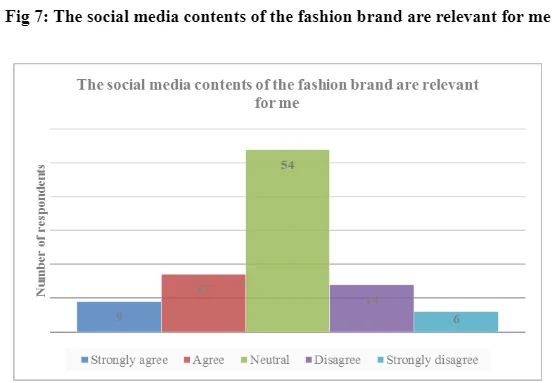
Concerning mobile applications, majority of the respondents (32 and 33 respectively) are strongly agreed and agreed with the fact that the fashion brands uses their individual mobile applications and different social media platforms in order to promote the products (see following figure). Through social media application, the fashion brands can provide customized product solutions and information to the people. Besides, it also helps to enhance the interaction with the customers and obtain knowledge regarding their activities and choices. Only 9 respondents are disagreed with this fact.
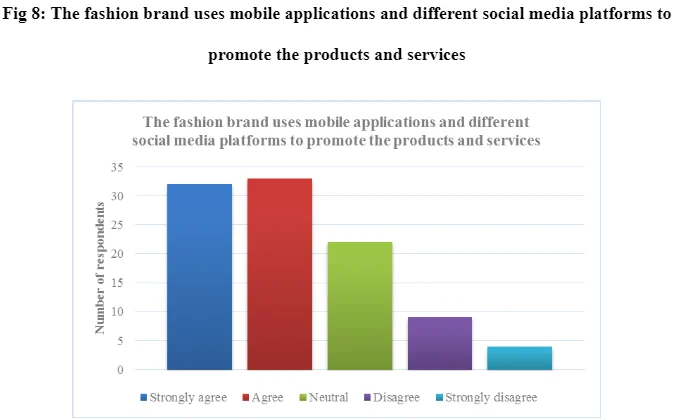
4.1.4 Branding
Branding is important marketing activity used by fashion companies in order to promote the products and social media can provide a useful medium for conducting branding activities. In order to understand the branding activities of fashion brand in social media, the respondents are asked to mark their opinions on series of statements. For instance, the respondents are asked if they find social media marketing of the fashion brand enjoyable. In this aspect, most of the respondents (62 out of 100) have agreed with the fact that the social media marketing of the fashion brand they like or use is enjoyable. 15 respondents are neutral on this fact and 7 respondents were disagreed on this statement (see following figure). This indicates that fashion brand intends to make their social media marketing effort entertaining for the users so that they find the brand exciting and become curious about the product offers. It assists in advertising the brand towards the vast audience.
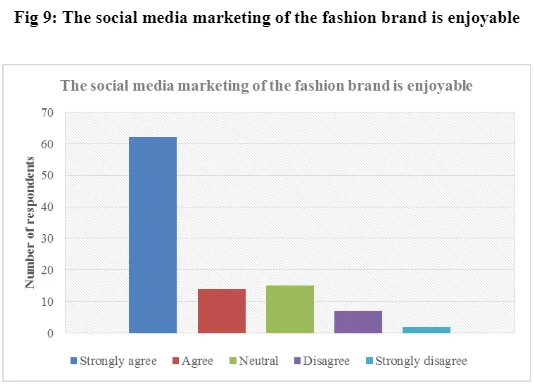
Most of the respondents (52 out of 100) also agreed with fact that the information shared in social media by the fashion brand is up to date. 18 respondents are neutral with fact (see following figure). It identifies that up to date information essential to make the brand active near the customers and so that people always recall the brand name while purchasing. With so many users using social media on regular basis, it gives an important channel for fashion brands to always notify about the updated product offerings so that it reaches to maximum number of people.
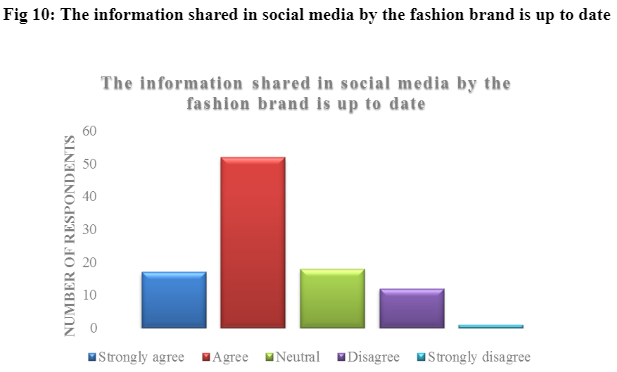
With regard to trendiness, majority of the respondents strongly agreed and agreed with the fact that the use of social media by the fashion brand is trendy (see following figure). This indicates that through social media, the fashion brand can develop the image of trendy in front of the young customers. This gives a positive reputation and help to become a style icon for the users. Most of the current generation and young users of social media desire to look like fashionable and social media gives the opportunity for the brands to appear like it, so that users can relate the brand to themselves.
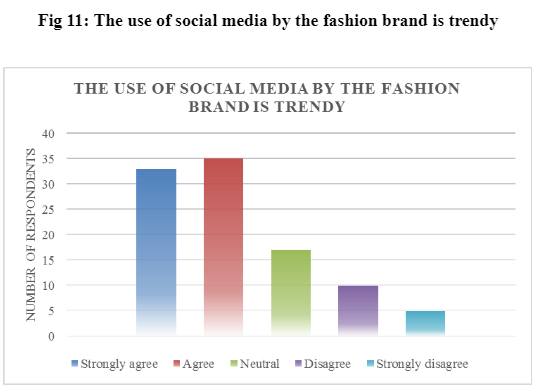
Regarding the advertisement given by the fashion brands in social media, most of the respondents (55 out of 100) are neutral with the fact that they like the advertisement of the fashion brands published in social media. 11 and 18 respondents are agreed and strongly agreed with this fact (see following figure). This specifies that to a certain extent, the fashion brands can provide interactive and amusing advertisements, which are useful and some users fund them amusing. Therefore, in order to be effective in social media, fashion brands require developing such advertisements which are interesting and are able to attract the attention of the users.

Most of the respondents also neutral (52 out of 100) with the fact that social media of the fashion brand provides them information they require. 18 and 14 respondents agreed and strongly agreed with this fact (see following figure). Therefore, from the response it can be stated that in social media people are able to seek information given by different users who are exposed to the fashion brand. Through providing remarks and comments, social media helps to provide important information to the users about the brand such as what other users are experiencing or felt after using the products of the brand. Such information cannot be obtained from other channel, except social media. Due to this reason social media has become useful network for branding for the fashion brands.
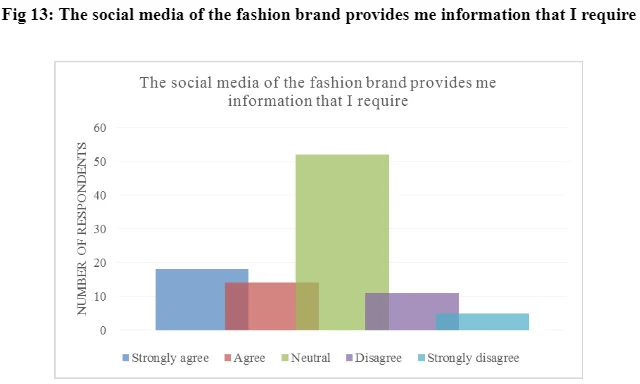
4.1.5 Brand Loyalty
Brand loyalty is the key objective of social media marketing activities made by the fashion brand. Through social media marketing and branding activities, fashion brands desire to make loyal customer base. To understand the level of brand loyalty by the users, the respondents are asked series of questions. In this context, most of the respondents (54 out of 100) have agreed with the fact that they are satisfied with the fashion brand. 19 respondents are neutral on this fact and only 15 respondents are disagreed with this fact (see following figure). This specifies that level of satisfaction is affected by the marketing activities performed by the fashion brands in social media. In order to maintain a positive brand image in front of vast audience of social media, most fashion brands develop such marketing strategies which are pleasing for the customers, making them satisfied towards the brands.
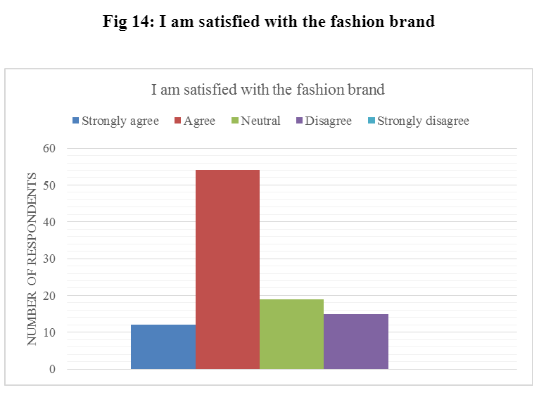
Majority of the respondents (51 out of 100) also agreed with the fact that they usually use the fashion brand as their first choice in comparison with the other brands. 13 respondents are neutral on this aspect and only 12 respondents are disagreed with this fact (see following figure). This finding shows that social marketing is effective in making a connection with the customers so that they relate themselves with the brand and consider it before making purchase decision.
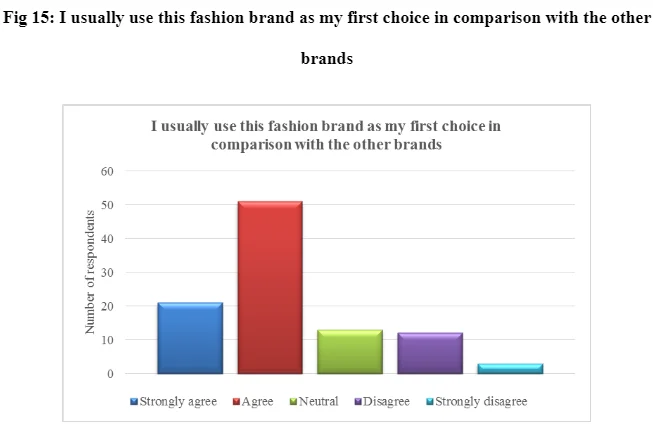
Finally, majority of the respondents (54 out of 100) also strongly agreed with the fact that they would recommend the brand to others through social media. 21 respondents were neutral on this fact (see following figure). Therefore from this response it can be stated that through social media, the users of the fashion brand can associate themselves and show others about using the brand as a personal style. This not only helps in exhibiting their individuality and choices to others, but also appeals other users to know about the brand and try to use the brand.
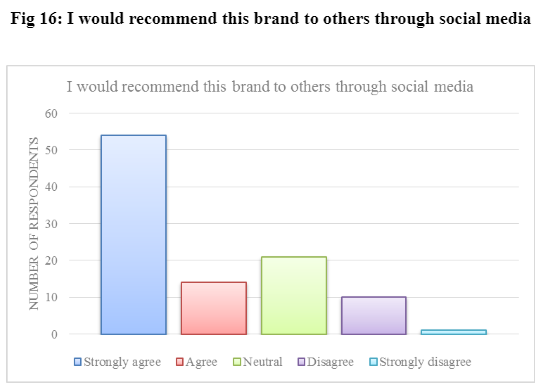
4.2.1 Correlation Analysis
In order to analyze if there is any relationship between social media marketing with branding and brand loyalty of the respondents, correlation analysis is conducted. The social media marketing of the fashion brand is analyzed by three key variables which are the marketing campaigns by the brand in social media site, regularly update contents in social media and use of mobile applications and social media platforms to promote the products and services. On the other hand, branding is analyzed by the enjoy ability of the social media marketing by the fashion brand fashion brand in social media. Brand loyalty is evaluated by recommendations of the brand to others by social media (see following tables).
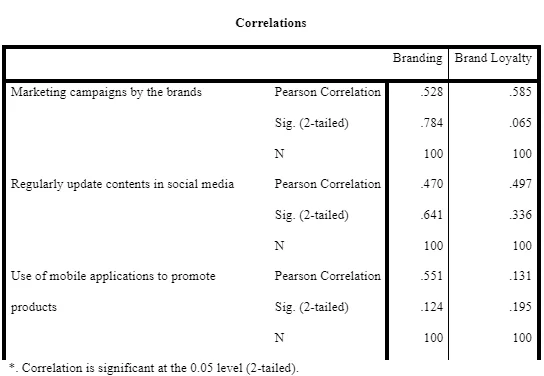
From the above table, it can be observed that the value of correlation coefficient between marketing campaigns by the brand in social media site and use of mobile applications and social media platforms to promote the products and services with branding is 0.528 and 0.551 respectively, which are positive and much closer to 1. Therefore, it can be stated that strong positive relationship exists between the variables. The value of correlation between regularly update contents in social media and branding is observed as 0.470, which specifies that positive relationship exists between these variables.
On the other hand, the value of correlation coefficient between marketing campaigns by the brand in social media site and brand loyalty is observed as 0.585, which is positive and closer to
1. Therefore, it can be stated that strong positive relationship exists between the variables. On the other hand, value of correlation coefficient between regularly update contents in social media and brand loyalty is 0.497, which is also positive. Hence, it also indicates existence of positive relationship between the two variables. Then again, the value of correlation coefficient between use of mobile applications and social media platforms to promote the products and services with brand loyalty is observed as 0.131, which is positive but not closer to 1. Therefore, it can be stated that weak positive relationship exists between the variables.
4.2.2 Regression Analysis
In order to analyze the significance of the relationships between the variables, regression analysis is conducted. The first regression is between social media marketing with branding, where marketing campaigns by the brand in social media site, regularly update contents in social media and use of mobile applications and social media platforms to promote the products and services are the independent variables, which are measured against key dependent variable, i.e. branding.
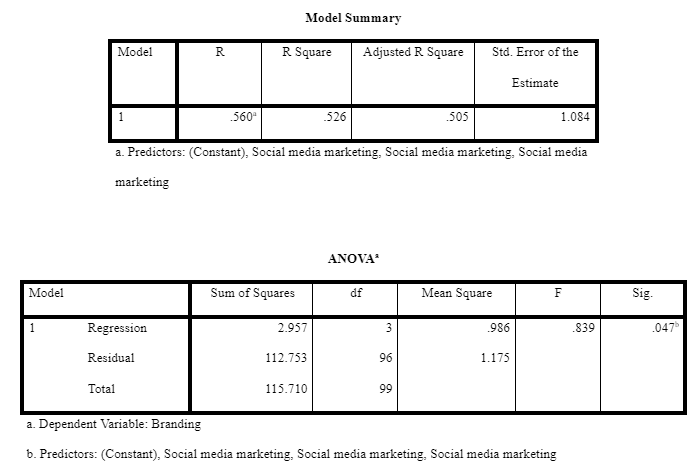
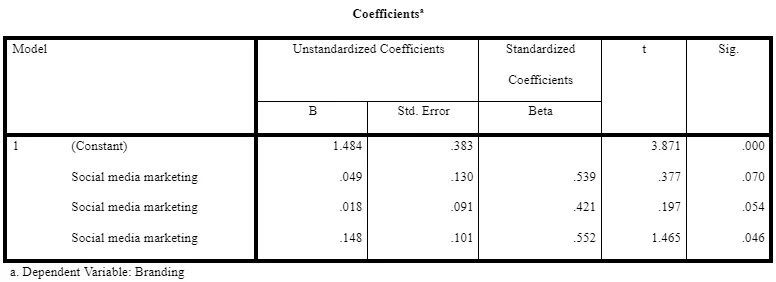
From the above analysis, it can be observed that the value of R2 is 0.526, which indicates that any changes in the independent variables can result in about 52% changes in the dependent variable, which is quite significant. Furthermore, the P value of the analysis is observed as 0.047, which is less than 0.05, i.e. P< 0.05. Therefore, it can be stated that there is statistically significant relationships between social media marketing and branding of the fashion brands.
In the similar context, in second regression, the key independent variables are marketing campaigns by the brand in social media site, regularly update contents in social media and use of mobile applications and social media platforms to promote the products and services, which is measured against brand loyalty of the respondents.
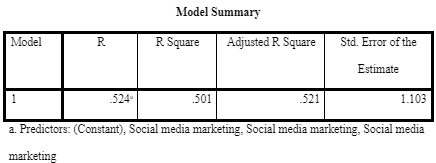
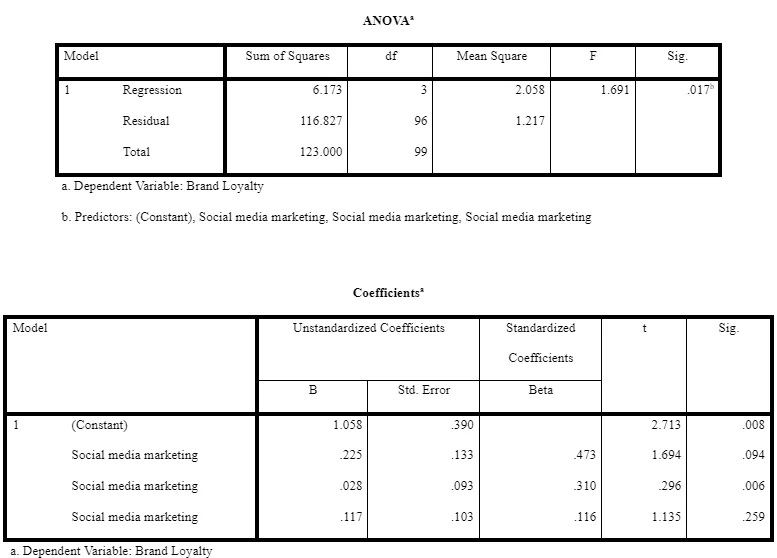
From the analysis, it can be observed that the value of R2 is 0.501, which indicates that any changes in the independent variables are related with about 50% changes in the dependent variable, which is quite significant. Furthermore, the P value of the analysis is observed as 0.017, which is less than 0.05, i.e. P< 0.05. Thus, it can be stated that the relationship between the variables are statistically significant. Hence, from the findings and analysis, it can be stated that there is statistically significant relationship between social media marketing, branding and brand loyalty of fashion brands.
Chapter 5: Discussion
5.1 Use of Social Media Marketing for Branding Purpose and Loyalty in the fashion Industry
This study has mainly focused on identifying the impact of social media marketing on branding in the fashion industry. It can be stated that every business organization needs to implement several marketing strategies for enhancing brand image and increasing sustainability in competitive markets. With the growing years, people become more conscious regarding the use of fashionable products in order to look attractive and presentable both in their personal and professional life. As per the current business infrastructure, most of the renowned business fashion retain organizations can be observed to use social media as an effective platform of marketing.
A customer becomes motivated to purchase a product being influenced by many things. Society, economic background, family, friends, environment these things control the minds of customers and motivate them towards purchasing. With the growing years, the internet has become the best way of communication and has brought a drastic change in the social infrastructure. Internet helps people to remain connected with their friends and near ones. In addition to that, they can trace their activity and get to know about their likings and perceptions (Fischer and Reuber, 2011). It can be observed that luxury fashion brands and social media are interconnected. Currently, people are quite active in social media and love spending times there. It can be stated that social media is a place through which the business organizations become able to reach and attract a large number of people within a short span of time. Social media can be considered as a tool, which provides the opportunity to the people to find out what they desire just by using their computers. On the other hand, the growing use of the internet has brought significant change in the buying behavior of consumers.
Business organizations can be observed to implement multiple strategies for increasing brand image in front of the customers. Usually, customers desire their organization to be socially responsible. Subsequently, businesses can be observed to perform many social activities, which help to increase the image of a company. The old communication process is utterly changed with the rapid use of the internet. Therefore, the business organizations are getting wide opportunity to communicate with a large number of people in order to create brands and to gain customers loyalty. With the help of social networking site, the planners get to know about the age and gender along with all other standards of customers. Therefore, they start notifying them with all relevant information about the products they have accessed and searched on the internet (Mohr, 2013). They explicitly elaborate all the information in their pages so that people can get know every detail about their favorite products and brands. Apart from that, business organizations can be observed to utilize the impression of celebrities for increasing the image of a brand. At the same time, customers also very likely to be influenced by the recommendation of their favorite celebrities.
It is very essential on the part of a global fashion retailer to know the awareness and perception of different market customers (Jayasuriya & Azam, 2017). Customers’ perception is not similar in all the places. Consequently, they need to apply different strategies to identify their concepts and demands. Though, people can easily find their favorite brands, information regarding a new brand, producer’s background and efficiency at the time making their buying decision (Ismail, 2017). In addition to that, people are also getting the opportunity to verify a product through the reviews of old users.
The scholar of this study has conducted a survey among hundred respondents in order to identify the influence of social media marketing over the customers. Additionally, the scholar wanted to know the way social media marketing can be utilized for increasing image brand image of a fashion company. Most of the young people have participated in this survey. It can be observed in the findings section that people have rightly confessed they often use the internet and quite active in social media. Facebook, Instagram, Tweeter these are the social sites they mostly like to spend their times, share their views and news feed. Among all the social sites, Facebook has attained the highest popularity among common people. Therefore, people also mentioned that they like to use branded products as it helps to carry their own images. They prefer to use brands like Nike, Gucci, Fendi, Calvin Klein. Though, choice varies from person to person.
In the literature review section of this study, it can be identified that social media is considered to be an effective communication tool, which is utilized by most of the contemporary fashion retail companies for communicating with the customers and to increase brand loyalty. Apart from that, social media is not only helpful for the companies, the customers also getting benefits from there. They are getting the opportunity to share information about products and services, they can express their perception regarding a product, get to know feedbacks of users within a fraction of time. It can be emphasized that the process and effectiveness of social media marketing are utterly different from that of the conventional marketing process. A solid social media strategy is required in order to sustain in the present competitive business infrastructure.
As per the literature review section of the present research study, different types of loyalty like customer loyalty, behavioral loyalty, and attitudinal loyalty can be attained through social media. Therefore, it has intensely impacted the fashion retail industry. A large number of people can be observed to take regular updates about the fashion industry, watch fashion shows and events, reads news related to fashion (Godey et al., 2016). It is revealed that almost 800 million people are using Instagram, which has reduced the gap between fashion brands and customers. On the other hand, customers place their order to purchase a product after viewing the user-generated content provided by the old users. It can be stated that a company gets success in business and become able to achieve its objectives by satisfying the customers. Subsequently, they need to give adequate focus in order to generate online marketing strategies to meet the expectation of customers.
5.2 Ways and Methods the Companies Can Use in the Fashion Industry
As mentioned in the literature review, it can be said that marketing through social media is very much different from marketing in the traditional way. By using innovative social media strategies, a company can stay competitive in the market and as a result, build a positive brand image for the company. There is a need for every company to hire a social media expert, who will advise on which content should be put on social media. Only then can it strike the perfect note on the mind of the consumers, and eventually make the consumers loyal towards the brand (Wolny and Mueller, 2013, p. 571). There are many social media platforms, and it is nearly impossible to manage all of them. So at first the social media expert of the company needs to assess which type of audience they want to target. Depending on that, they should choose such platforms, where it is easy to communicate with them. In the present situation, mobile applications are the best way where the consumers can directly get updated information from the brand, which increases their trust towards the brand.
The brand can attain loyalty in many ways, such as through customer loyalty and behavioral loyalty, which is to retain old customers through better services and good offers. Other than that, through attitudinal loyalty, the old customers share the name of the brand through word of mouth and help the company in taking corrective measures without expecting anything in return. Earlier, nearly up to two decades ago, fashion was consumed by the consumers through magazines and printing press or television. However, with changing time, Facebook and Twitter had become the platform to share these along with YouTube (Kontu and Vecchi, 2014, p. 242). But currently, attaching hash tag with the name is enough to find anything related to the topic, which includes fashion as well, which is why Instagram has become so famous in such a short span of time. Instagram helps to bridge the gap between fashion brands and the person who is interested in buying the fashion product. So, Instagram had added the new feature “Instagram Shopping”, where the brands tag the consumers, which further will help in point of sale of the brand.
From the findings, it can be understood that mostly females, who are adults but below the age of 40 are more interested in fashion, which means millennial, which are students or are private sector employees are more interested in fashion (Parsons, 2013, p. 34). It can be found that the respondents, who are in social media, mostly use Facebook, then Instagram, YouTube, and WhatsApp in the more to less sequence. Social media mentioned above are used by most of the participant for more than one hour on average and in a few cases; it can be up to six hours. It is also found that most of the respondents are aware of fashion brands such as Nike, Prada, Gucci and so on, and some of them are even consumers of the brands. Another fact that came up is that most of these brands use those social media to update their new edition, new collection, latest trends, and exclusive offers.
Chapter 6: Conclusion and Recommendations
6.1 Conclusion
The positive impact of social media is seen in every sphere of the world. Fashion industries are getting broader opportunities to establish their position among people. Social media marketing is also providing scopes for gaining brand loyalty in the world market. It is significantly impacting the retailing sectors in case of brand loyalty and branding purposes. Each and every human being is using social media to know more and to gain knowledge about certain ideas. Due to this reason, many companies are taking certain initiatives for expanding their brand image with the help of social media.
The organizations are creating social media websites with the help of which, the consumers are able to choose and select products according to their requirement. It can be observed that the present generation is quite conscious about such matters. It becomes difficult for companies to motivate and retain them through the use of old technology. Because of this, new and advanced technologies are used for the betterment of the organizations. From many recent studies, it can be noticed that the organizations are becoming very much active in social media.
Social media has also opened up new scopes for conducting activities related to business. The people are able to communicate with their customers for knowing their viewpoints and wants. For the fashion industry, social media marketing has become a vital part of every organization. It can be stated that if an organization is able to fulfill the desires of the consumers, that organization is capable of gaining an effective branding image in the fashion industry.
There are certain ways of gaining loyalty by satisfying them. Such methods include customer loyalty, behavioral loyalty and attitudinal loyalty. It can be observed that for gaining the customer’s loyalty, the foremost step is to create a good relationship with them. Thus, it can be said that companies need to attract their customers to gaining brand loyalty with the help of them. Services and products also play a vital role in this perspective. The organizations need to produce good quality products for their customers along with this; they should also deliver a quality amount of services to them. In this manner, they will be able to deal with the behavioral loyalty. Attitudinal loyalty is also a different kind, which in turn, helps in understanding the demands and needs of the customers.
Social media marketing is said to be a helpful factor for a company in attaining brand loyalty because, with the help of this, the customers from all over the world are able to know about the company. They can choose their products by sitting at their place. These give better scopes to the customers as well. In this manner, by delivering a quality amount of products and services the company will be able to satisfy their customers, which in turn, will help the company to achieve its brand image or loyalty. From this, it can be also being stated that customers play a significant role in this process.
From the survey, it can be observed that a majority of the respondents were females within the age group of 20 to 39 years and the majority of them were students or private segment employees. They tried to state their views according to their perception. It can be noticed that a majority of the respondents were in for of Facebook, Instagram and YouTube. From this, it can be understood that Facebook is responsible for improving the purchasing style among the customers. A majority of the respondents were stating that they use social media for one to three hours a day. This states that customers usually take a long time for interacting with the websites and choosing their desirable products.
Social media marketing is leading among the respondents. It can be proved from the survey that was conducted. The respondents stated that there are no definite fashion brands they prefer. They usually purchase what catches their eyes. They also mentioned that different marketing campaigning was also done through which, the fashion brands are able to present their products. On the other hand, efficient media is responsible for attracting customers. A majority of them also mentions that they find marketing interesting through the medium of social media. The sites they prefer are up to date as stated by them. Thus, they also mention that social media is an efficient way of developing the image of a brand. This can be done through advertisement. Respondents are greatly agreeing with the fact of brand loyalty.
Along with this, they were also seen recommending some ways for gaining development. The positive relation is observed between the update contents in social media and mobile applications for promoting products. Then the positive relationship is noticed in between updates and brand loyalty. From the regression, it can be understood that there is relation between branding, brand loyalty and social media marketing. In this way, the effect and impact of social media marketing can be understood with the help of this survey report.
6.2 Recommendations
From the above discussion, it can be noticed that social media marketing is influencing the branding and brand loyalty of the fashion industry. It is also giving better opportunities to the companies to expand in a better form. However, there are many companies where social media marketing ways are not used (Chae and Ko, 2016). It can be recommended that companies should implement the new and modern ways of social media marketing. This will help the organizations to grow in an appropriate manner. Customers will also be able to know about the websites and the products the company have. In this way, the company will be able to gain brand loyalty from them.
The companies should proceed with some promotions and discounts. It can also be suggested that they should attract customers by promoting their products. They can also use the celebrity endorsement methods for promotion purposes. Along with this, they should continue giving attractive seasonal discounts for their betterment. This will be helpful in accomplishing the customers’ satisfaction. Advertising techniques should also be applied for further development (Kodippili et al., 2016). In this manner, the companies will be able to reach its height. On the other hand, it can also be recommended that the companies should create their websites in such a manner that it will look attractive to the general public.
The companies should open up an opportunity for the customers to offer their feedback, which in turn will be helpful for the companies. According to that, the organizations will be able to know the perceptions of the consumers and will make such changes (Godey et al., 2016). Thus, consumers will be satisfied with this and this, in turn, will increase the brand loyalty of that company. The information and updates that the companies provide should be accurate and up to the requirement. This will help the consumers in gaining some knowledge about the company. In this manner, the companies will gain success.
The companies should create a medium through which, they will be able to communicate with their customers. For this, the organizations should post their products on the daily basis. Along with this, they should use useful hashtags so that the consumers will be able to reach them within a short time (Ismail, 2017). They should post the pictures of their customers wearing those dresses that were brought from their sites. This will also increase the chances of gaining brand image or loyalty. In this manner, the organizations or companies will be able to reach their heights in the fashion market. In addition, this will also increase their brand loyalty.
Satisfaction of the customer is the vital part for attaining the brand loyalty. For this reason, the companies should take certain useful approaches through which, they will be able to deliver a quality amount of services and products through social media. It is their responsibility to gain the customers’ satisfaction (Schivinski and Dabrowski, 2016). This is because this will be of great benefit in achieving brand loyalty or branding. It can be recommended that the websites of the companies should look attractive. Along with this, they should make the customers curious about their products so that they can eagerly check those. This will create a satisfaction within the customers, which makes them purchase those products. In this manner, brand loyalty can be achieved with the help of social media marketing.
6.3 Future Research Scope
The research study mentions the positive impact of social media marketing in gaining brand loyalty. Along with this, it also presents data statistically that makes the research paper more appropriate. However, the paper lacks in giving details about the effect that may due to the social media marketing. It also did not state about the problems that the older people face while marketing through social media. The issues they need to go through while doing their shopping through social media. In this manner, the paper creates a scope for the future research on this particular topic.

References
- Biglin, Y., 2018. The Effect Of Social Media Marketing Activities On Brand Awareness, Brand Image And Brand Loyalty, Business & Management Studies: An International Journal.
- Bryman, A. & Bell, E. (2007). Business Research Methods. New York: Oxford University Press Inc.
- Castellan, C. M. (2010). Quantitative and Qualitative Research: A View for Clarity. International Journal of Education, 2(2), 1-14.
- Chae, H. and Ko, E., 2016. Customer social participation in the social networking services and its impact upon the customer equity of global fashion brands. Journal of Business Research, 69(9), pp.3804-3812.
- Chan, Y.Y. & Ngai, E.W.T., 2011. “Conceptualizing electronic word of mouth activity. An input-process-output perspective”, Marketing Intelligence & Planning, Vol. 29 No. 5, pp. 488-516.
- Chu, S.-C. & Kim, Y., 2011. “Determinants of consumer engagement in electronic word-ofmouth (eWOM) in social networking sites”, International Journal of Advertising, Vol. 30 No. 1, pp. 47-75.
- Churchill, G.A. Jr & Iacobucci, D., 2005. Marketing Research: Methodological Foundations, Thomson South-Western, Cincinnati, OH.
- Colgate, M., Buchanan-Oliver, M. & Elmsly, R., 2005. “Relationship benefits in an internet environment”, Managing Service Quality, Vol. 15 No. 5, pp. 426-436.
- Comm, J., 2009. Twitter Power: How to Dominate Your Market One Tweet at a Time, John Wiley & Sons, Hoboken, NJ.
- Constantinides, E. & Fountain, S.J. 2008. “Web 2.0: conceptual foundations and marketing issues”, Journal of Direct, Data and Digital Marketing Practice, Vol. 9 No. 3, pp. 231-244.
- Corstjens, M. & Umblijs, A., 2012. “The power of evil. The damage of negative social media strongly outweigh positive contributions”, Journal of Advertising, Vol. 52 No. 4, pp. 433-449.
- Creswell, J. (2008). Educational Research; Planning, Conducting and Evaluating Quantitative and Qualitative Research, 4th Edition. New York: Pearson International Edition.
- Creswell, J. (2011). Research design. Thousand Oaks, Calif.: Sage Publications.
- Devi, R. & Menezes, C., 2016. Effect of Social Media Marketing on Brand Loyalty formation from the Perspective of Online Consumer. The IASMS Journal of Business Spectrum, Vol. 9, No. 1, pp. 34-37.
- Fanion, R. 2011, “Social media brings benefits to top companies”, Central Penn Business Journal, Vol. 27 No. 3, p. 76.
- Fashion United Group, 2017. Global Fashion Industry Statistics-International Apparel. [Online] available at: https://fashionunited.com/global-fashion-industry-statistics/ [Accessed 03 February 2019].
- Fischer, E. and Reuber, A.R. 2011 “Social interaction via new social media: (How) can interactions on twitter affect effectual thinking and behavior?”, Journal of Business Venturing, Vol. 26 No. 1, pp. 1-18.
- Gay, L.R. & Diehl, P.L. (1992) Research Methods for Business and Management. New York: Mc. Millan Publishing Company.
- Godey, B., Manthiou, A., Pederzoli, D., Rokka, J., Aiello, G., Donvito, R. and Singh, R., 2016. Social media marketing efforts of luxury brands: Influence on brand equity and consumer behavior. Journal of business research, 69(12), pp.5833-5841.
- Greasley, P. (2009). Quantitative data analysis using SPSS. Maidenhead: Open University Press. http://www.theatlantic.com/technology/archive/2011/07/infographic-using-social-media-to-build-brand-loyalty/241701/ (accessed 07 January 2012).
- http://www.theatlantic.com/technology/archive/2011/07/infographic-using-social-media-to-build-brand-loyalty/241701/ (accessed 07 January 2012).
- Ismail, A.R., 2017. The influence of perceived social media marketing activities on brand loyalty: The mediation effect of brand and value consciousness. Asia Pacific Journal of Marketing and Logistics, 29(1), pp.129-144.
- Ismail, A.R., 2017. The influence of perceived social media marketing activities on brand loyalty: The mediation effect of brand and value consciousness. Asia Pacific Journal of Marketing and Logistics, 29(1), pp.129-144.
- Jackson, N. (2011) Infographic: Using Social Media to Build Brand Loyalty. Retrieved from:
- Jayasuriya, N. A. & Azam, S. M. F., 2017. The Impact of Social Media Marketing on Brand Equity: A Study of Fashion-Wear Retail in Sri Lanka. International Review of Management and Marketing, Vol. 7, No. 5, pp. 178-183.
- Kim, A. J. & Ko, E., 2010. Do social media marketing activities enhance customer equity? An empirical study of luxury fashion brand. Journal of Business Research, Vol. 65, No. 10, pp. 1480-1486.
- Kim, A. J. & Ko, E., 2010. Impacts of Luxury Fashion Brand’s Social Media Marketing on Customer Relationship and Purchase Intention. Journal of Global Fashion Marketing, Vol. 1, No. 3, pp. 164-171.
- Kodippili, G. & et. al., 2014. The Influence of Social Media Marketing on Customer Loyalty towards Clothing Stores. Conference: National Conference on Technology and Management, pp. 59-68.
- Kodippili, G., Jayawickrama, M.T.N., Yugandari, W.D.Y., Pamudini, S.D.H. and Samarasinghe, H.M.U.S.R., 2016. The Influence of Social Media Marketing on Customer Loyalty towards Clothing Stores.
- Kontu, H. and Vecchi, A., 2014. Why all that noise–assessing the strategic value of social media for fashion brands. Journal of Global Fashion Marketing, 5(3), pp.235-250.
- Kothari, C. R. (2004). Research Methodology: Methods and Techniques. New Delhi: New Age International.
- Ler, S., 2014. The attitudes of consumers towards viral marketing in Malaysia. Universiti Tunku Abdul Rahman. [Online] available at: https://libezp.utar.edu.my/login?url=http://eprints.utar.edu.my/id/eprint/1297 [Accessed 03 February 2019].
- Mohr, I., 2013. The Impact of Social Media on the Fashion Industry. [Online] available at: http://digitalcommons.www.na-businesspress.com/JABE/MohrI_Web15_2_.pdf [Accessed 03 February 2019].
- Muniz, A.M. and O’Guinn, T.C., 2001. “Brand community”, Journal of Consumer Research, Vol. 27 No. 4, pp. 412-432.
- Nambisan, S. and Baron, R.A., 2009. “Virtual customer environments: texting a model of voluntary participation in value co-creation activities”, Journal of Product Innovation Management, Vol. 26 No. 4, pp. 388-406
- Nanji, A., 2017. The Most Popular Social Networks with Millennial, Gen X, and Baby Boomers. [Online] available at: https://www.marketingprofs.com/charts/2017/31792/the-most-popular-social-networks-with-millennials-gen-x-and-baby-boomers [Accessed 03 February 2019].
- Oliver, P. (2010). The student's guide to research ethics. Maidenhead, Berkshire, England: McGraw-Hill/Open University Press.
- Park, H. & Cho, H., 2012. “Social network online communities: information sources for apparel shopping”, Journal of Consumer Marketing, Vol. 29 No. 6, pp. 400-411.
- Parsons, A., 2013. Using social media to reach consumers: A content analysis of official Facebook pages. Academy of Marketing Studies Journal, 17(2).
- Phelps, J.E. & Et. Al., 2004. “Viral marketing or electronic word-of-mouth advertising: examining consumer responses and motivations to pass along email”, Journal of Advertising Research, Vol. 44 No. 4, pp. 333-348.
- Roehm, M. & Tybout, A. 2006. “When will a brand scandal spill over, and how should competitors respond?”, Journal of Marketing Research, Vol. 43 No. 3, pp. 366-373.
- Safko, L., & D.K. Brake, 2009. The Social Media Bible. New Jersey: John Wiley & Sons, Inc.
- Schivinski, B. and Dabrowski, D., 2016. The effect of social media communication on consumer perceptions of brands. Journal of Marketing Communications, 22(2), pp.189-214.
- Shau, H.J., Muniz, A.M.J. and Arnould, A.J., 2009. “How brand community practices create value”, Journal of Marketing, Vol. 73 No. 5, pp. 30-51.
- Smith I. A. (2006). Research ethics. New York: Routledge.
- Thackeray, R. & Et. Al., 2008. “Enhancing promotional strategies within social marketing programs: use of Web 2.0 social media”, Health Promotion Practice, Vol. 9 No. 4, pp. 338-343
- Trusov, M., Bucklin, R. and Pauwels, K., 2009, “Effects of word-of-mouth versus traditional marketing: findings from an internet social networking site”, Journal of Marketing, Vol. 73 No. 5, pp. 90-102.
- Vollmer, C. and Precourt, G., 2008. Always On: Advertising, Marketing, and Media in An Era of Consumer Control, McGraw-Hill, New York, NY.
- Wolcott, H.E., 1994. Transforming Qualitative Data: Description, Analysis and Interpretations, Sage, Thousand Oaks, CA.
- Wolny, J. and Mueller, C., 2013. Analysis of fashion consumers’ motives to engage in electronic word-of-mouth communication through social media platforms. Journal of marketing management, 29(5-6), pp.562-583.
- Yen, R.H.J. and Gwinner, K.P., 2003. “Internet retail customer loyalty: the mediating role of relational benefits”, International Journal of Service Industry Management, Vol. 14 No. 5, pp. 483-500.
- Zhung, B. W., 2017. Influence of Social Media Marketing, Brand Loyalty and eWOM towards Consumers’ Purchase Intention. Universiti Tunku Abdul Rahman. [Online] available at: http://eprints.utar.edu.my/2791/1/13UKM06827_Report.pdf [Accessed 03 February 2019].
Appendices
Appendix 1: Questionnaire for the Respondents
- Please specify your gender.
Male
Female
- Please specify your age.
Below 20
20 to 29
30 to 39
40 to 49
50 and above
- Please specify your occupation.
Student
Businessperson
Self employed
Housewife
Unemployed
Private segment employee
Public segment employee
- Which of the following social media site you use most?
Facebook
Google+
Instagram
Twitter
LinkedIn
Pinterest
YouTube
Others, please specify
- How many times do you use social media?
Less than 1 hour a day
One to three hours a day
Four to six hours a day
More than six hours a day
- Are you conscious about fashion brands like Prada, Nike, Gucci, Calvin Klein and Fendi etc?
Yes, a few brands that I love
Not really, I just purchase what I like
- Please consider your recent opinion of a fashion brand you use and specify your view from strongly agree = 1 to strongly disagree = 5.
- With the same fashion brand in mind, give your view on following statements from strongly agree = 1 to strongly disagree = 5.
- After considering social media marketing of the fashion brand please provide your opinions on the following statements from strongly agree = 1 to strongly disagree = 5.
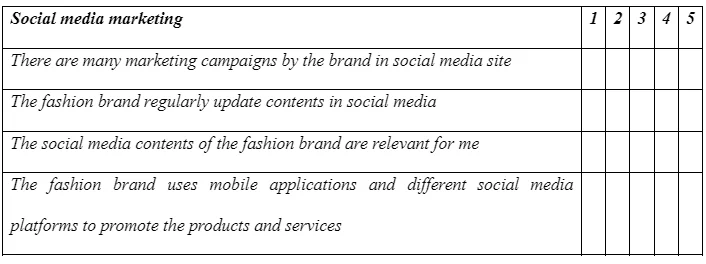
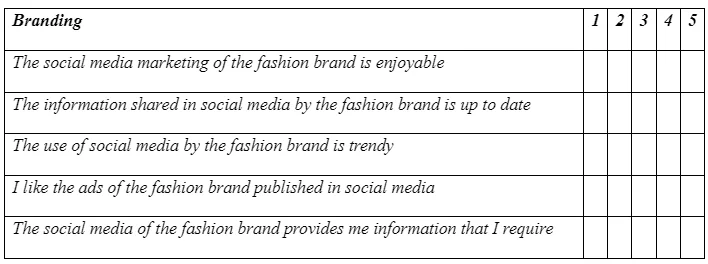

- 24/7 Customer Support
- 100% Customer Satisfaction
- No Privacy Violation
- Quick Services
- Subject Experts



